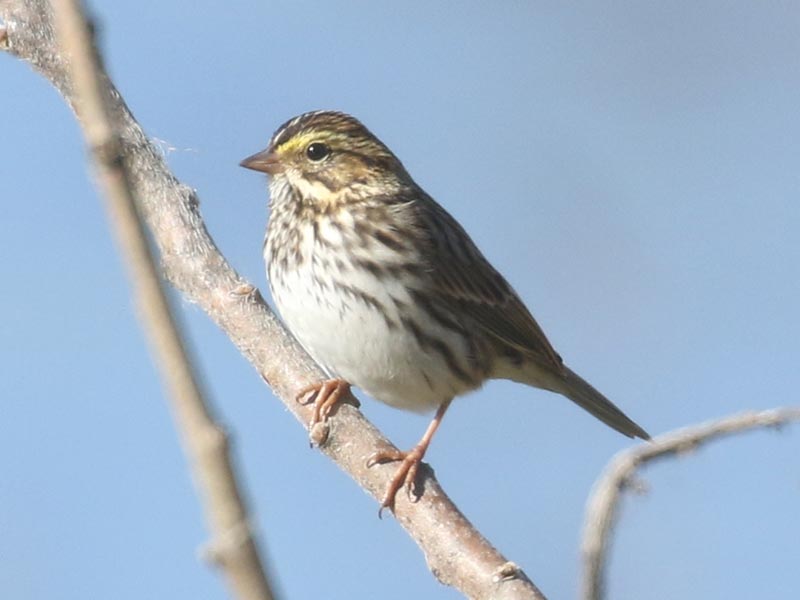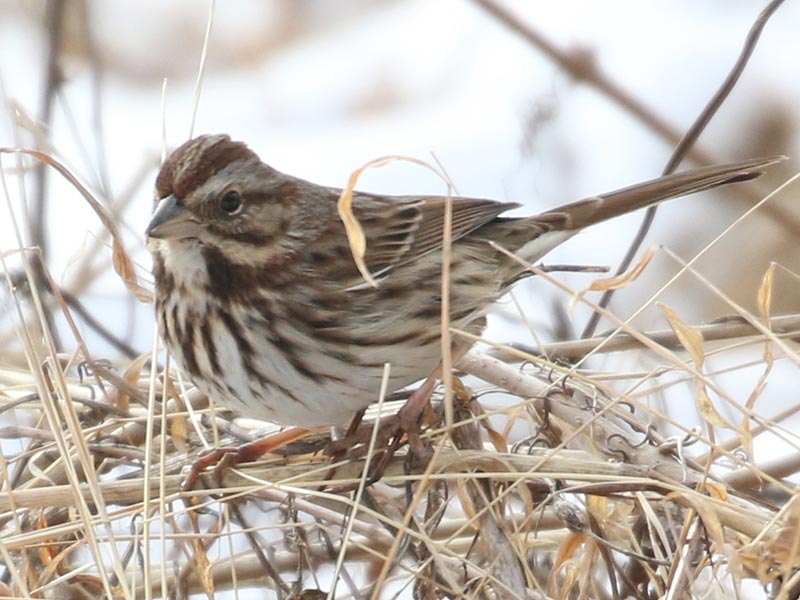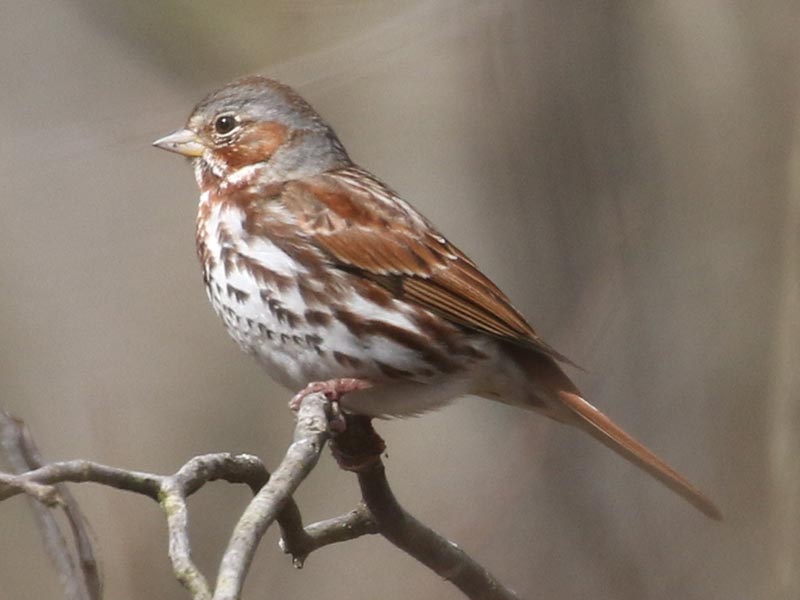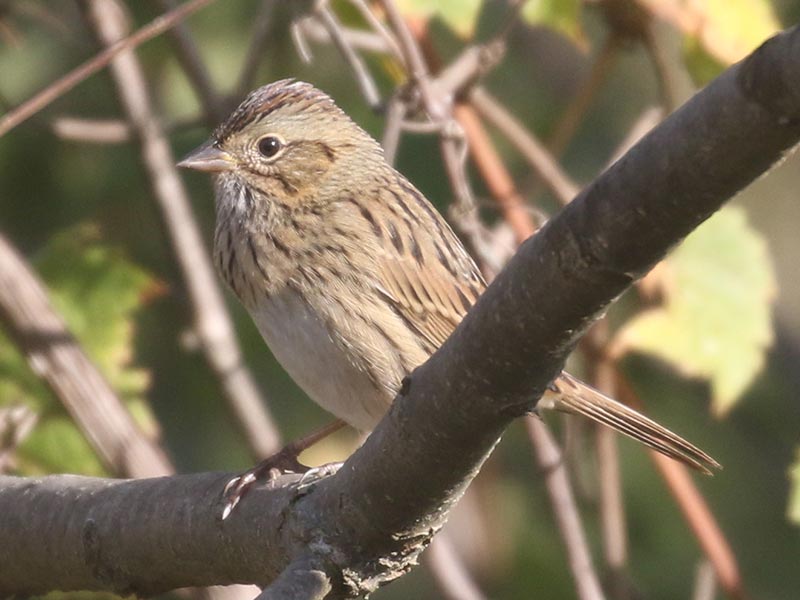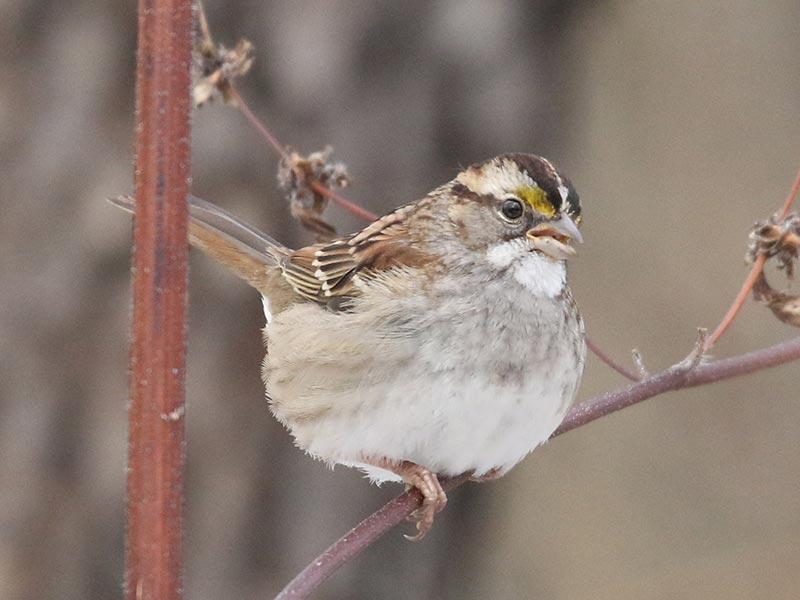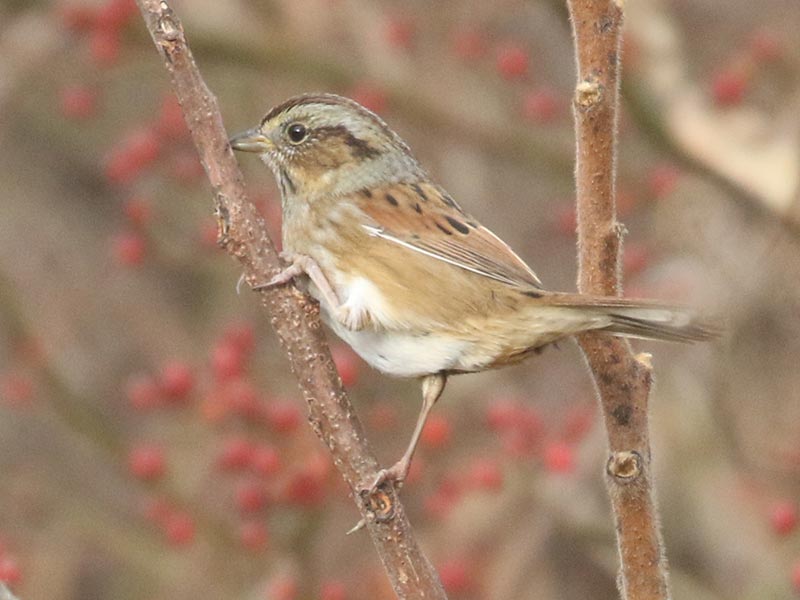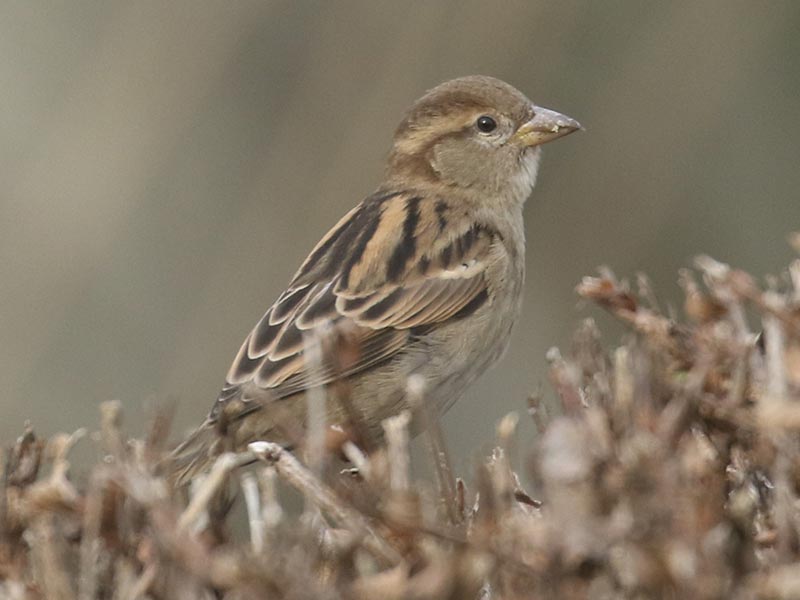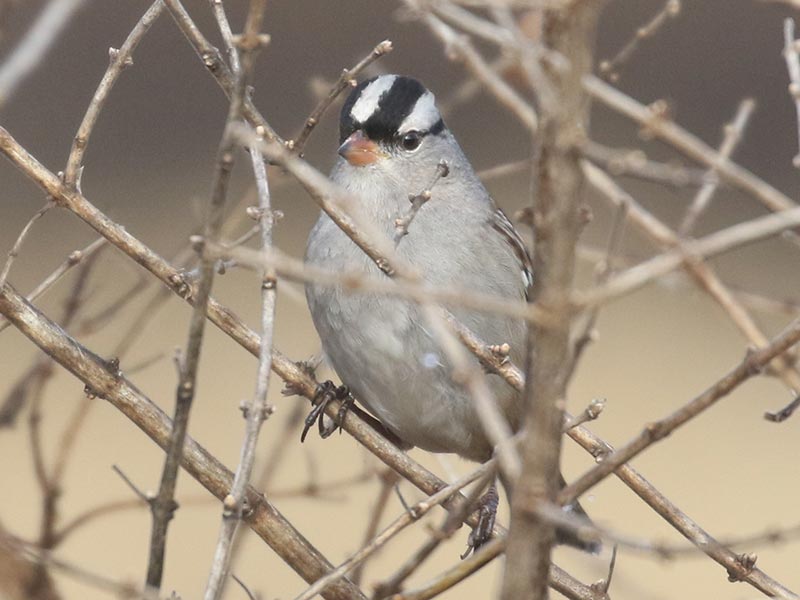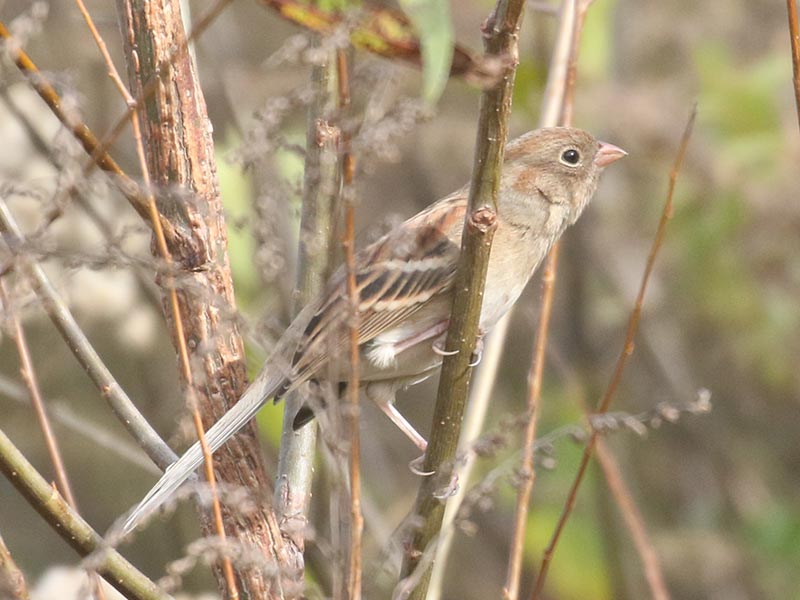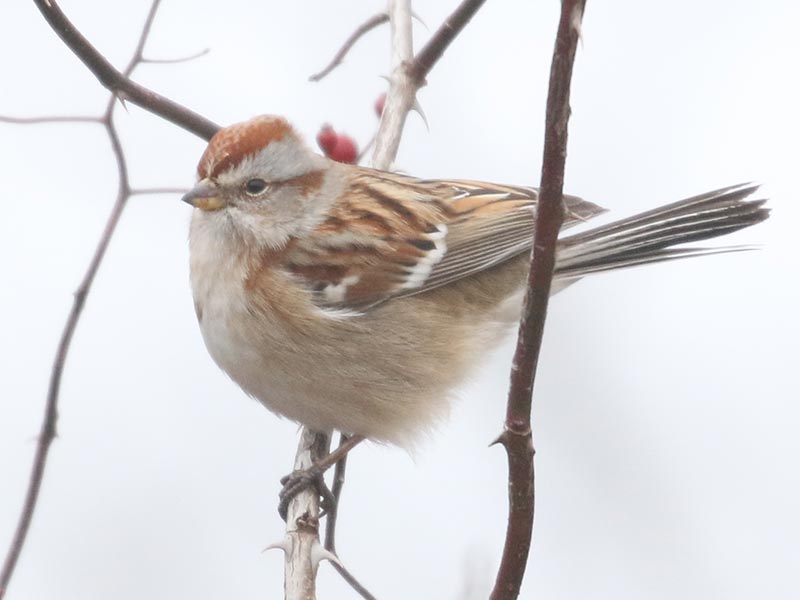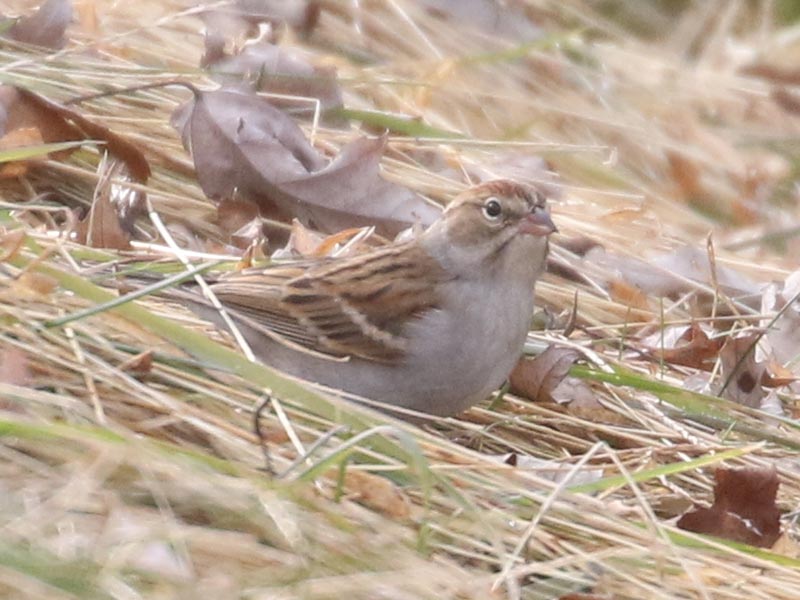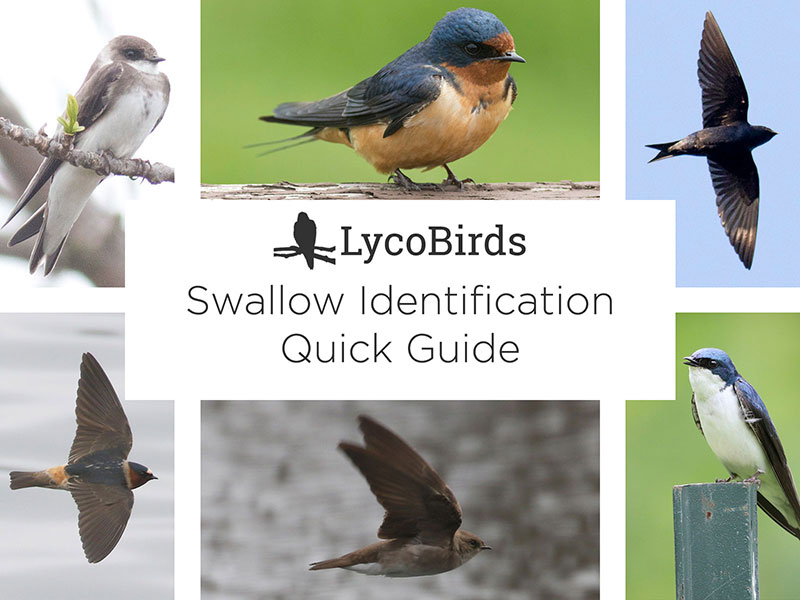Winter Sparrow Identification
Sparrows are a family group that many birders struggle to get a good handle on, but while most of them share certain characteristics — small, brown, etc. — once you know what to look at, most individuals you encounter are fairly straightforward to identify.
You could write an entire book about sparrow ID (and several have been written!), so to simplify the process of learning, and to keep this from turning into something unusable, this guide is aimed at beginner to intermediate level in inland locations in the northeast, with a particular emphasis on Pennsylvania since that is where I am based. If you bird in coastal areas, or farther south/west, there will be additional species to consider. For birders in the target area, this will quickly get you up to speed with well over 99% of the sparrows you will encounter during winter.
The winter species are a great place to start building up your identification skills, and will serve as a springboard to learning the additional sparrow species that migrate through and/or nest in the northeast. For the most part, I will try to avoid jargon — at the risk of losing a bit of precision in my description of field marks — but it shouldn't detract from making accurate identifications, and will hopefully serve to lessen the barrier to entry.
That said, here are a few terms you should know, since they come up a few times here, and are important terms to know outside of sparrows as well:
- Rufous
- Reddish-brown color seen in many bird species
- Lore(s)
- The area on the head between the eye and the bill
- Plumage
- Used in an identification context, simply the specific color patterns created by the feathers of a bird. For example, many species have two distinct "looks" throughout the year, called breeding plumage and nonbreeding plumage, or males and females of many species have separate plumages (often, with immature males looking similar to the female plumage)
This guide is broken up into four sections:
- Distinctive sparrows
- Streaked sparrows
- Unstreaked sparrows
- Sparrow-like species
Let's get started.
Distinctive Sparrows
We'll get these two out of the way first. They are fairly easy to separate from the other sparrows, because they don't really look like what you would typically consider a sparrow. They don't even have the name "sparrow," but they are in the same family as the other North American sparrows, so I didn't want to exclude them.
Dark-eyed Junco
One of the most familiar winter species, often flocking and visiting feeders, and rarely doing much to hide their presence. This species has a wide range of plumages among all of the subspecies, but in the east, nearly all of them are the slate-colored form. The "cleanest" examples of that form (e.g., adult males) are completely dark gray from above, with a white belly and white outer tail feathers that flash when they fly. There aren't really any species that have a similar color pattern, other than Black Phoebe, which isn't really a species you have to consider in the east (and note bill color and behavior as other means of separating those two).
Immatures and females can have various amounts of brown in the sides and on the back, but share the same basic color pattern. They all have a small pink bill.
ID Keys: Dark gray and possibly some brown everywhere above a white belly; white outer tail feathers; pink bill.
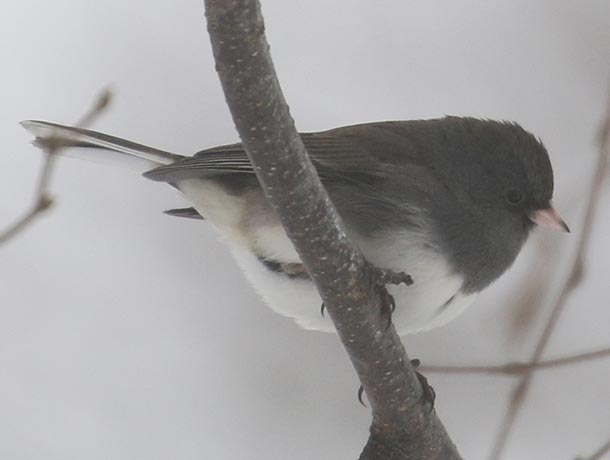
White outer tail feathers are visible on the underside of the closed tail
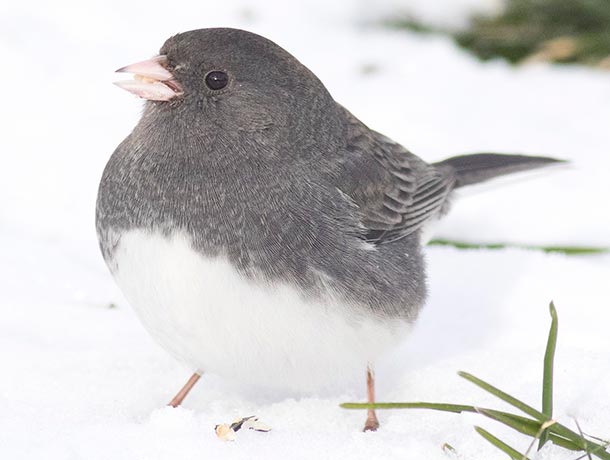
Adult males are typically dark gray except for white belly
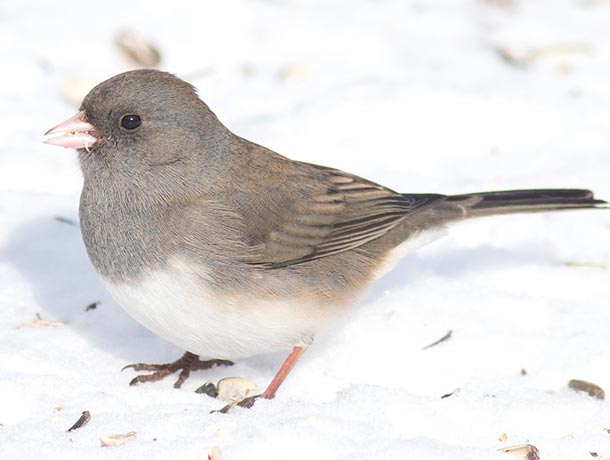
Same basic color pattern as the all-gray birds, but with brown in the sides and back
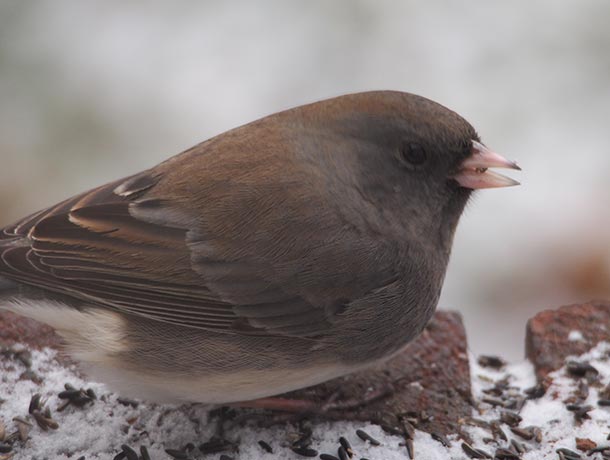
Upperside can range from solid gray to very brown
Eastern Towhee
Although quite common during the warmer months, they are pretty scarce in most areas of Pennsylvania and northward during winter. They tend to spend their time in brushy habitats, and aren't always easily seen, but listen for their loud alert whistle to give away their presence. The tricolored black (replaced by brown in females), rufous, and white plumage is unlike any of the other sparrows except the extremely similar western species Spotted Towhee, which is nearly identical except for its namesake white spotting on the upperside — the two used to be considered a single species called "Rufous-sided Towhee" but have since been split into two species. They are also quite large for sparrows. Especially during late snowfalls, they may show up at backyard feeders (preferring seeds on the ground), and are sometimes confused with orioles, but note the white front, different bill shape and ground-feeding habits.
ID Keys: Rufous sides; white belly; black or brown neck, head, and back; larger size than other sparrows.
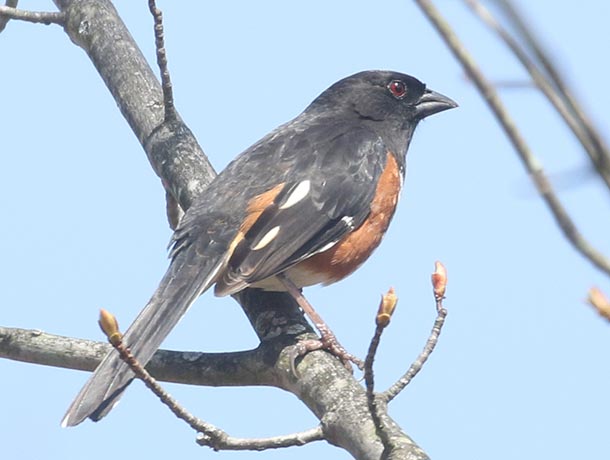
Quite striking in the sun, with red eyes, and solid patches of black, rufous, and white
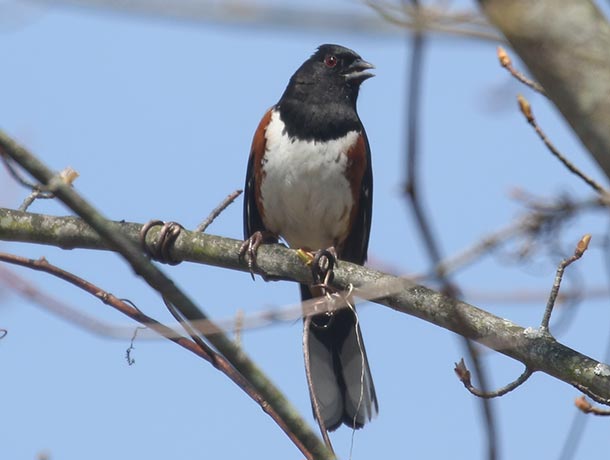
Sometimes confused with orioles, but note the extensively white belly and different bill shape (and exhibit different behavior)
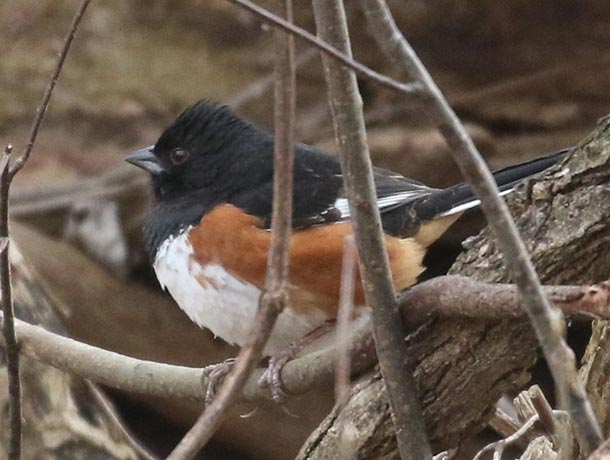
Usually found on or near the ground in brush
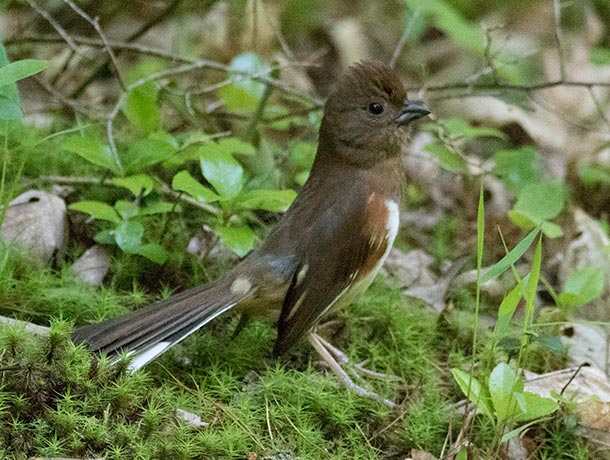
Females have essentially the same plumage pattern as males, with the black replaced by brown
Streaked Sparrows
Typically, the first thing you want to look at when trying to identify a sparrow is whether the front is streaked or not. This will quickly narrow your options, and allows you to move on to other details. During winter, the streaked sparrows are relatively easy, since one of the species is far more common than the rest.
Song Sparrow
This is the default streaked sparrow, and typically outnumbers the other species in this section quite significantly. So, really, when you see a streaked sparrow, you should ask yourself "Is there any reason this isn't a Song Sparrow?"
The general characteristics of this species are somewhat messy streaking usually coalescing into a central spot and bold dark wedges in the throat area. They also have a fairly long tail. Note that there is a large variation in plumage across their range, but these characteristics are typical of birds in the northeast.
ID Keys: Somewhat messy streaking; dark wedges in throat; default streaked sparrow.
This is one you want to really get a good grasp on as it serves as the base for identifying the other three streaked sparrows.
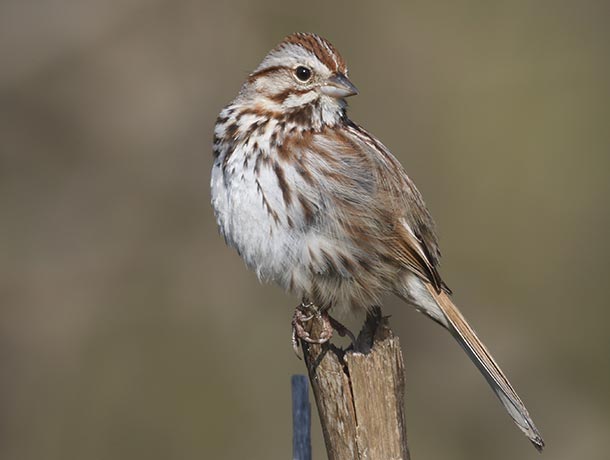
Long tail, dark wedge near throat
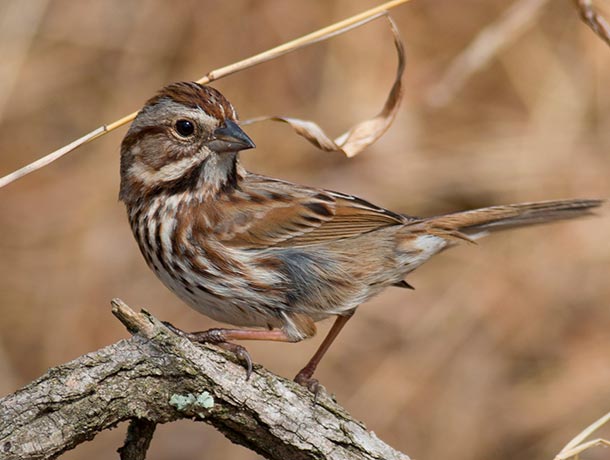
Dark wedge near throat, messy streaking
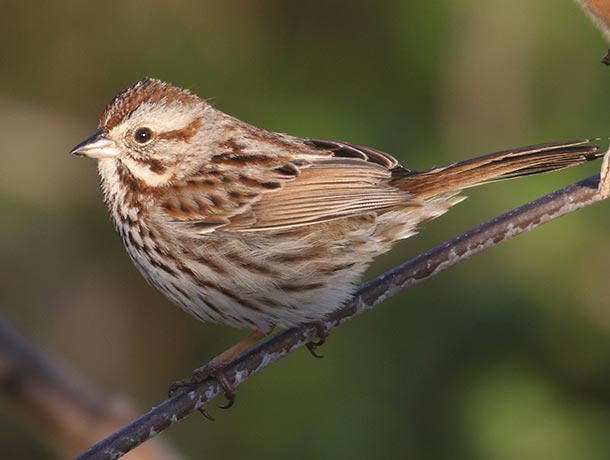
Long tail, dark wedge near throat
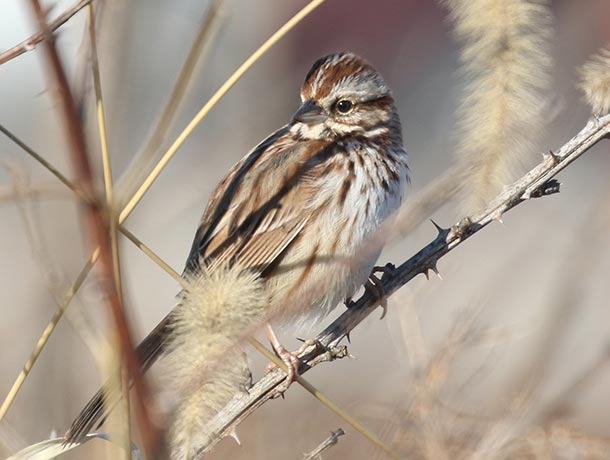
Even without a clear look at all of the specific field marks, the head pattern should become instantly recognizable after a while
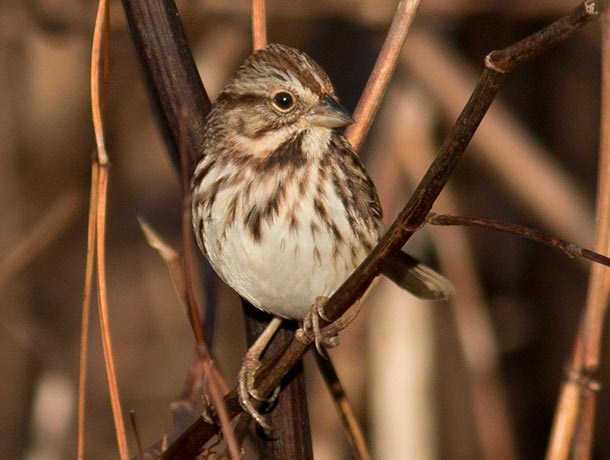
Messy streaking with central spot
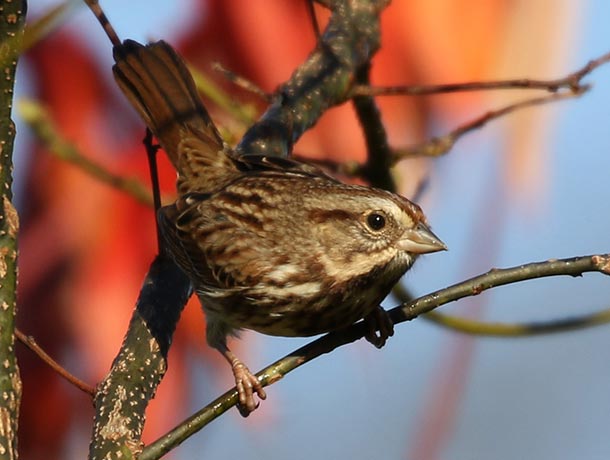
Messy streaking, long tail
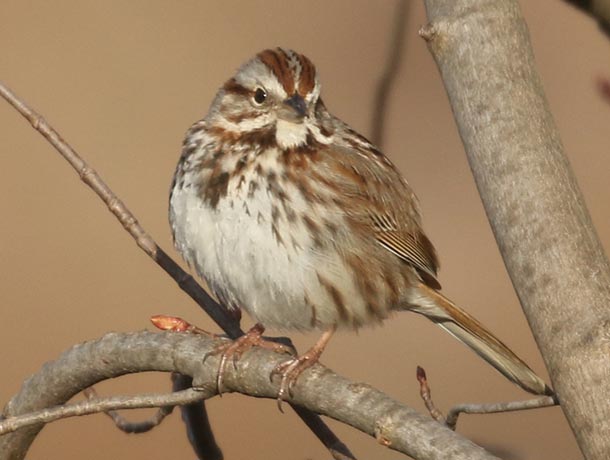
Messy streaking with central spot
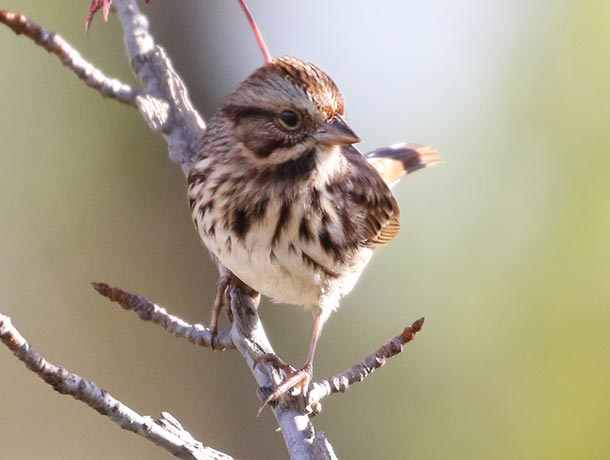
Dark wedge near throat, messy streaking
Lincoln's Sparrow
In the east, this species tends to winter pretty far south, so it's not one you will encounter much, but it's worth being aware of, especially because you'll see winter reports of them (which may not all be accurate — a lot of people find sparrows difficult to identify, which is why you're here, isn't it?).
Lincoln's Sparrows are incredibly refined-looking birds. They are well-proportioned and all of their markings appear quite crisp and precise. The base color of the chest and sides (under the streaking) is a buffy tan color, contrasting with a white belly. The streaking itself is very crisp — like it was drawn on with one of those ultra-fine tip Sharpies. The throat area also differs from Song Sparrow, with very fine streaking on the throat itself (when seen well), and with less bold dark markings around the throat.
Note that some Song Sparrows can show a buffy color under the streaking, so use multiple field marks to confirm the ID, especially in winter, when Lincoln's are uncommon in the northeast.
ID Keys: Buffy wash serves as a base under extremely fine streaking; fine streaking in throat; generally tidy-looking; if you can't decide, it's probably not a Lincoln's.
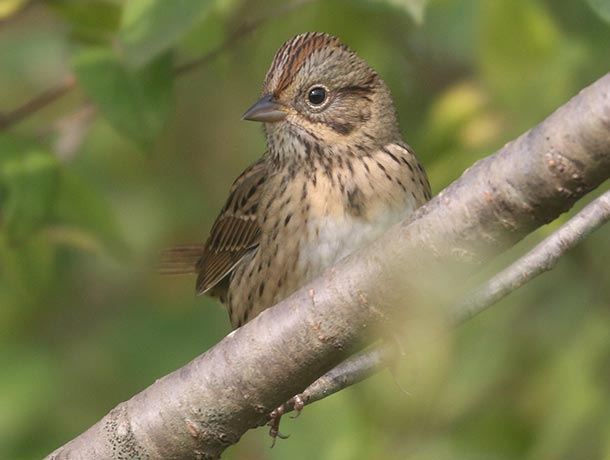
Very refined and tidy
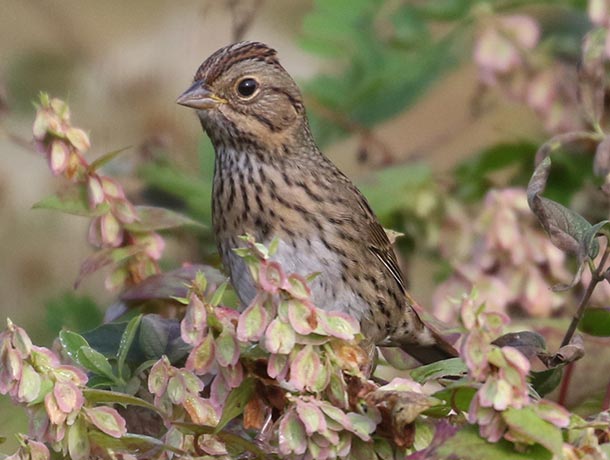
Crisp markings, buffy base color to chest and sides
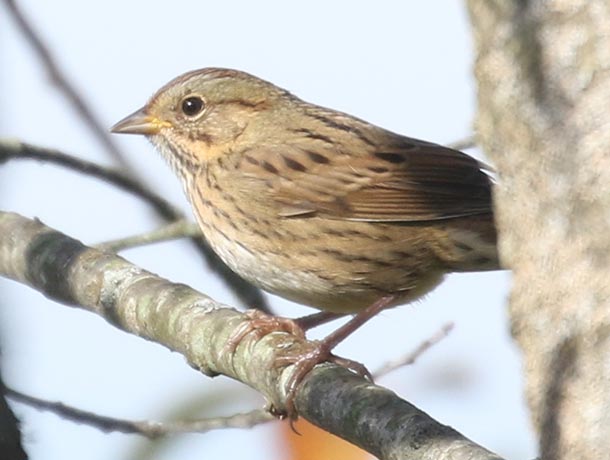
Buffy sides, crisp streaking, no bold dark wedge in throat
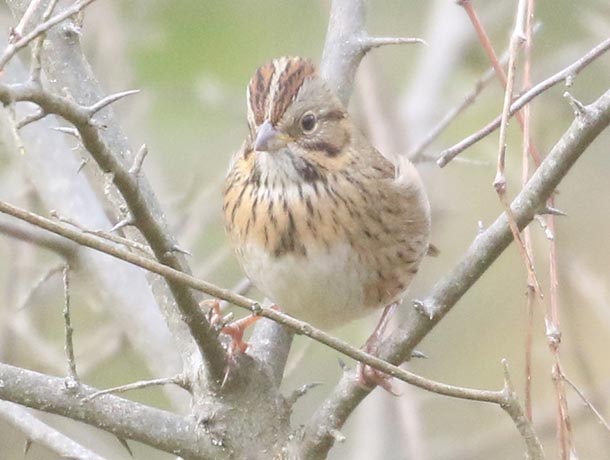
Finely streaked throat
This video covers separating Song Sparrows and Lincoln's Sparrows in the fall, which is when most Lincoln's Sparrows are seen in the northeast, but the all the field marks are valid in the winter too:
Savannah Sparrow
Savannah Sparrow is similar to Song Sparrow, but are "crisper" looking overall and have a smaller pink bill. The most drastic plumage difference from Song Sparrow is the presence of yellow lores, which can often continue up over the eye, but the amount of yellow is variable, and some individuals show very little. There are also subtle structural differences — most notably, Savannah Sparrows show a shorter tail which often appears notched at the end. They tend to favor more open habitats, and can even be found foraging in farm fields in winter like Horned Larks (or other species with similar habits). They are not terribly abundant in the northeast during winter, especially away from the coast.
ID Keys: Yellow lores; crisp streaking; short notched tail.
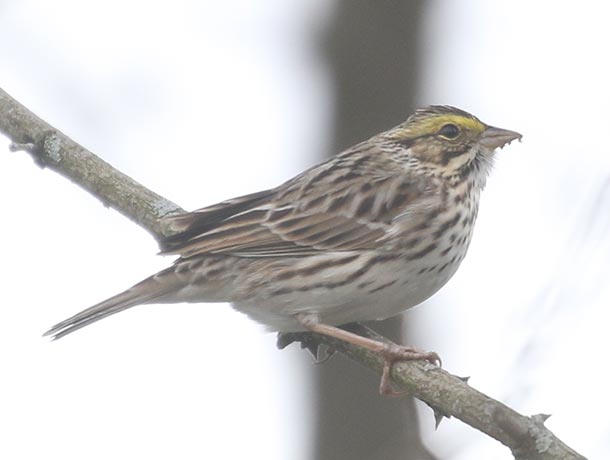
Pretty short tail (compare to Song Sparrow)
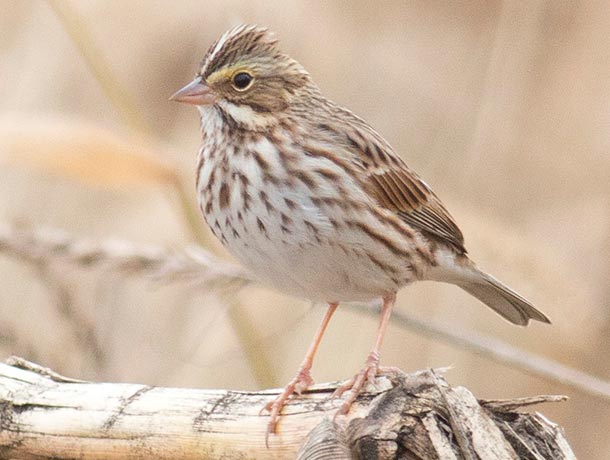
Notch in tail visible from some angles
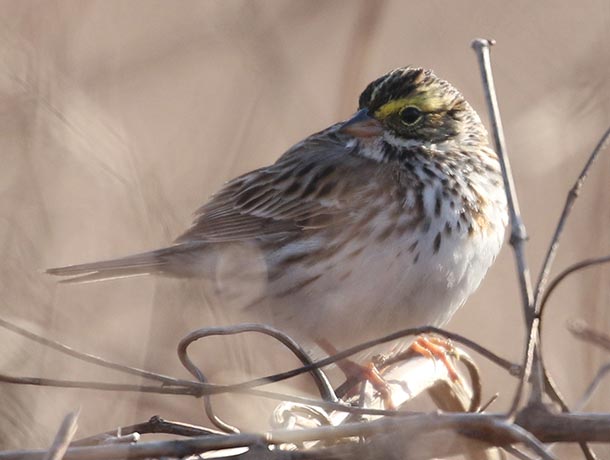
Crisp streaking with a pink bill and typically obvious yellow around the eye
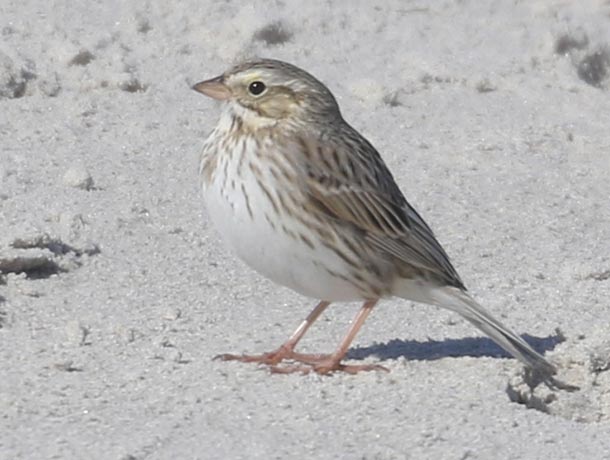
Wide variation in plumage across its range, such as this paler individual representing the "Ipswich" form
Fox Sparrow
This species is fairly cold-tolerant, but tends to winter a little south of the core northeast area this guide targets — but it's not unusual for some to be around in winter, especially in Pennsylvania. They are often found in fairly thick brush, but they can turn up at feeders as early migrants, particularly during inclement weather. Look for their feeding technique of using both feet at the same time to scratch at the ground.
This is another sparrow that has a huge variation in plumage across their whole range, but in the east, nearly all birds are very red, with an overall richer earthy rufous color that is different than the other streaked sparrows. They also typically have gray on the head and back. The streaking is very messy, and some of the crisper individual streaks appear as small chevrons (inverted V). They are also built more robustly than the other streaked sparrows, almost recalling a towhee, but not quite as large.
ID Keys: Extensive rufous color pattern; large and stocky.
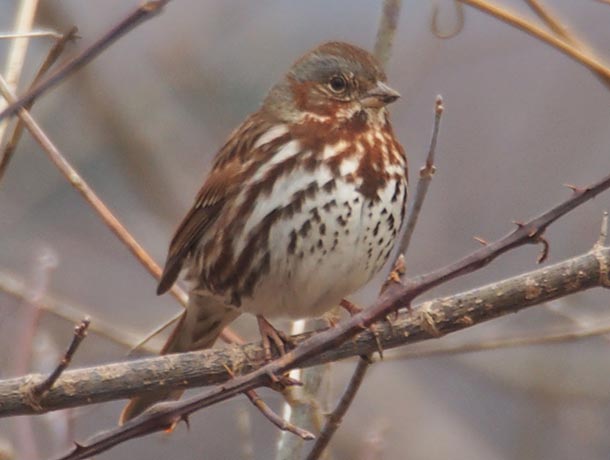
Overall richer earthy red-brown color different than the other streaked sparrows
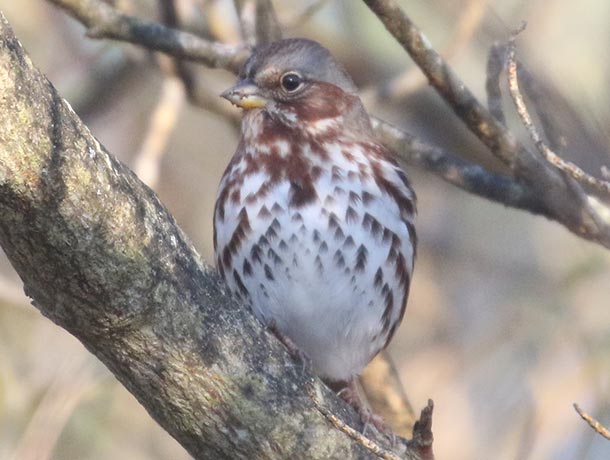
Messy streaking, but often the streaks closer to the belly are crisper chevrons
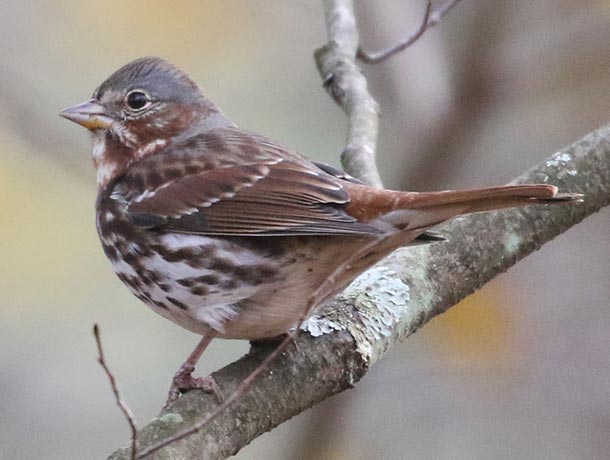
Large for a sparrow, both in size and build, almost recalling a towhee in that regard
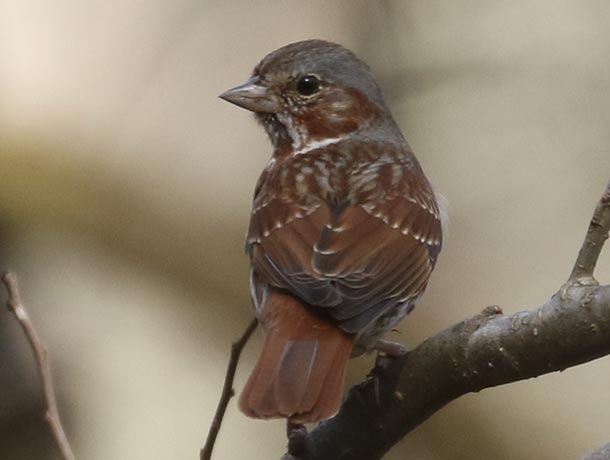
Back is also extensively reddish, but with some gray mixed in. Very different color pattern from the other streaked sparrows
Streaked Sparrow Practice Quiz
Unstreaked Sparrows
There are a few more unstreaked sparrows than streaked, but not to worry, once you know what to look for, you'll be separating them with ease. Some of these species can show faint streaking on the chest, but nowhere near as bold as the species covered in the previous section.
American Tree Sparrow
Decidedly a winter-only sparrow, this species nests well north of the U.S. (except Alaska). They are fairly common in the core of their winter range, but can be localized based on habitat (favoring brushy areas). Where you find one, you will often find many.
The most common confusion species is Chipping Sparrow (covered next), but American Tree Sparrows have a larger-feeling build, and a rufous eyeline (instead of black) that does not continue onto the lores. For much of the winter, many Chipping Sparrows will show a patterned top of the head, versus the solid rufous on American Tree Sparrow (breeding plumage Chipping Sparrows have a solid cap too, so be careful relying on that alone).
One of the most cited field marks for this species is the bicolored bill, with a grayish top and yellow bottom. They also tend to show a single dark spot in the middle of the chest.
ID Keys: Rufous cap and eyeline; bicolored bill; dark spot in middle of chest shown by many.
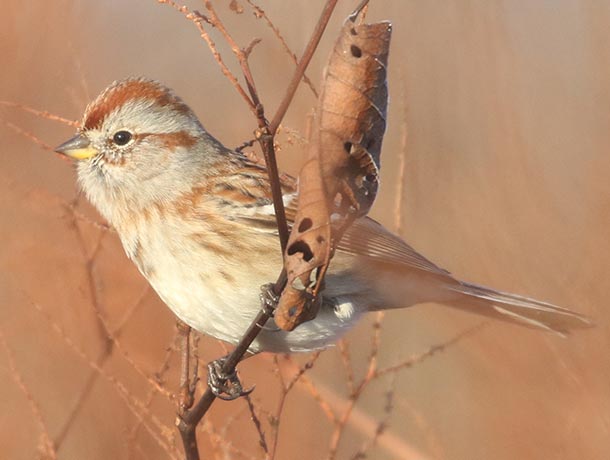
Rufous eyeline that does not continue through the eye onto the lores
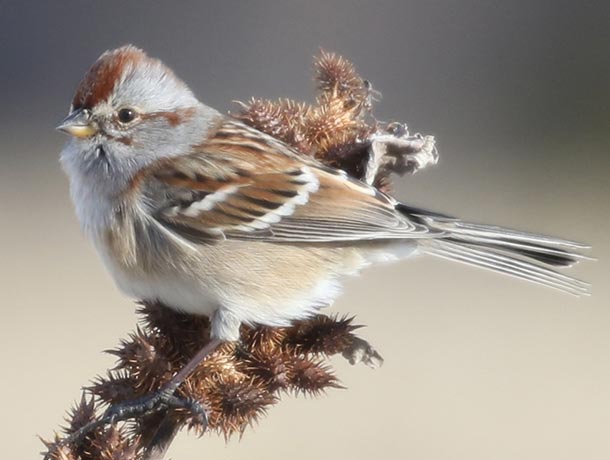
Solid rufous crown
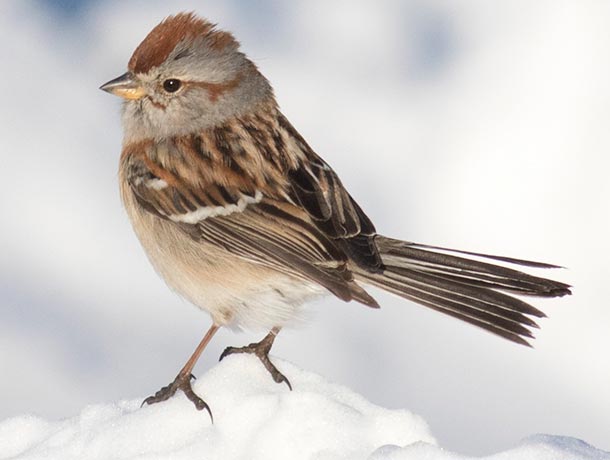
Top of bill is gray, bottom is yellow
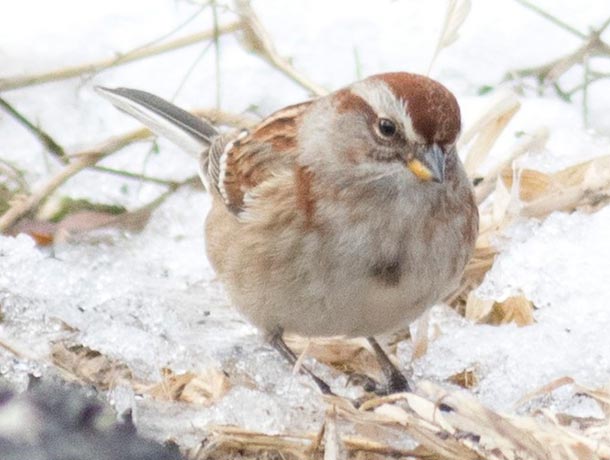
Dark spot in center of chest
Chipping Sparrow
While extremely abundant in the northeast during the warm months, this species mostly clears out for winter, although a few individuals may stick around — typically mixing in with flocks of other sparrows, such as juncos. Commonly will forage out in the open.
Compared to the other unstreaked sparrows, Chipping Sparrow is most likely to be confused with American Tree Sparrow. Compared to that species, note the small pinkish bill (not bicolored) and dark eyeline that continues onto the lores (by far the most important detail to remember for this species — although it can be somewhat faint on some individuals in winter). Winter individuals often have dull reddish streaked crowns, but especially towards spring, they can have a fairly solid rufous crown (which is what they show in breeding plumage). With browner cheeks in winter, their white eye arcs often stand out more than against their gray cheeks in breeding plumage. They also show a gray rump, which helps to solidify the ID versus some of the similar-looking rare options (like Clay-colored Sparrow).
Chipping Sparrows also have a fairly unique build compared to the other common unstreaked sparrows, with a more compact structure that makes them seem "closer to the ground."
ID Keys: Dark eyeline continues through eye onto lores; small pinkish bill; small, compact structure.
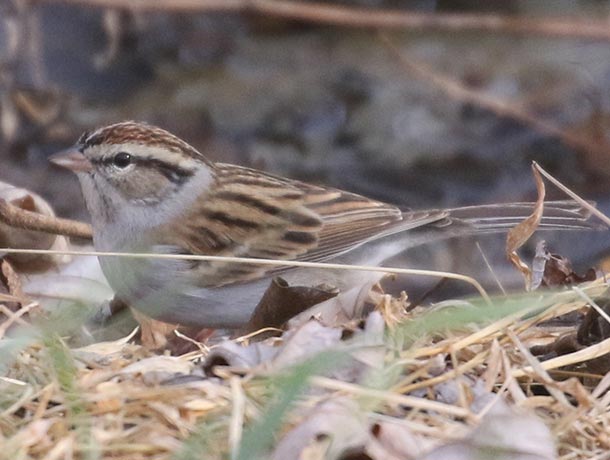
Dark eyeline continues onto lores
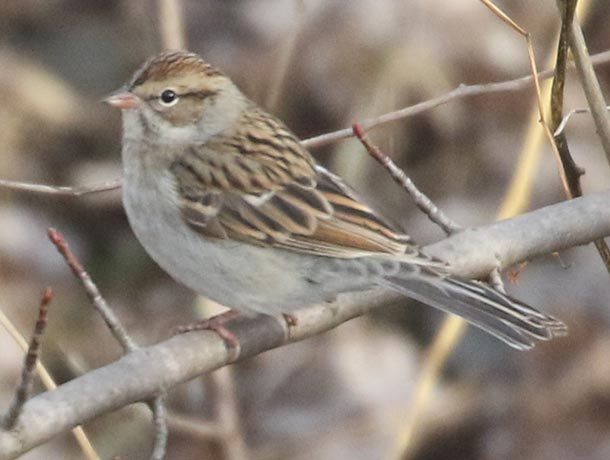
Rufous in the crown, pinkish bill
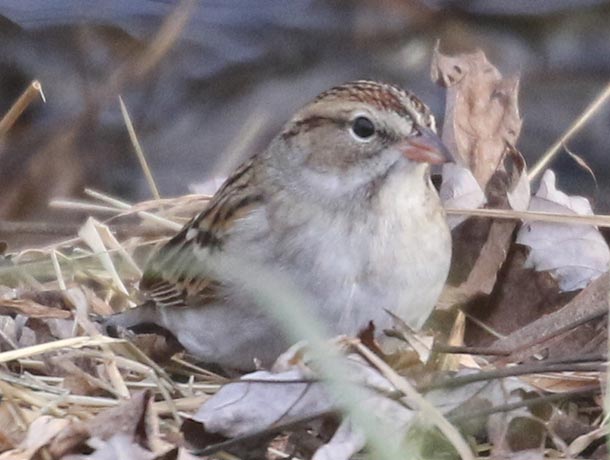
Eyeline continues onto lores, white eye arcs more noticeable in winter
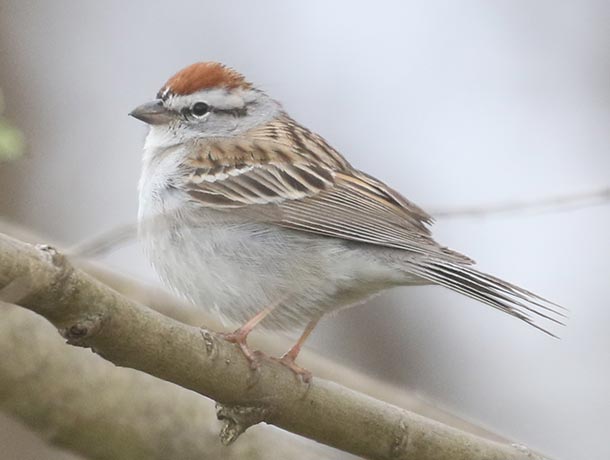
Full breeding plumage attained by spring
This video covers separating Chipping Sparrows and American Tree Sparrows:
White-throated Sparrow
One of the most common winter sparrows, and can actually be present in much of the northeast year-round (although localized and much less abundant in summer). This one is fairly distinctive. Their yellow lores with high contrast white throat are unique among the unstreaked sparrows. This species has a fairly stocky build, and tend to be in brush, but they aren't really secretive, and often come out in the open.
There are two color morphs for this species, tan-stripe and white-stripe (referring to the pattern on the head). The boldness of the head pattern tends to be a bit muted in the winter for both morphs, but white-stripe still tend to look brighter.
ID Keys: Yellow lores and distinct white throat.
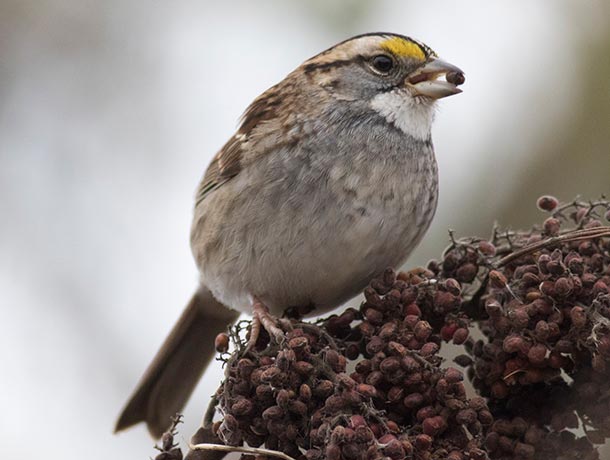
Some birds show some "faux" streaking, but never as distinct as the "streaked" sparrows
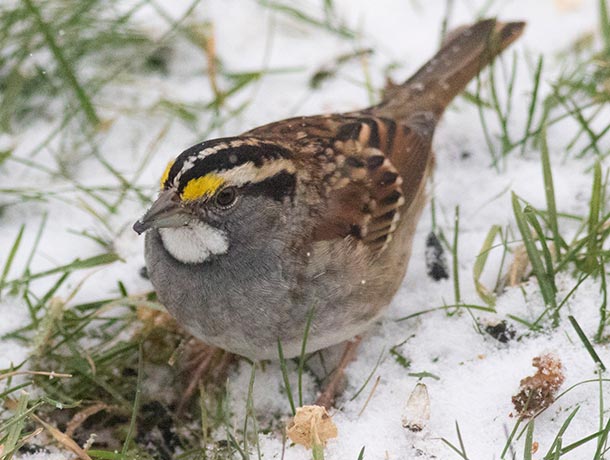
Strong yellow lores and bold white throat unique among the unstreaked sparrows
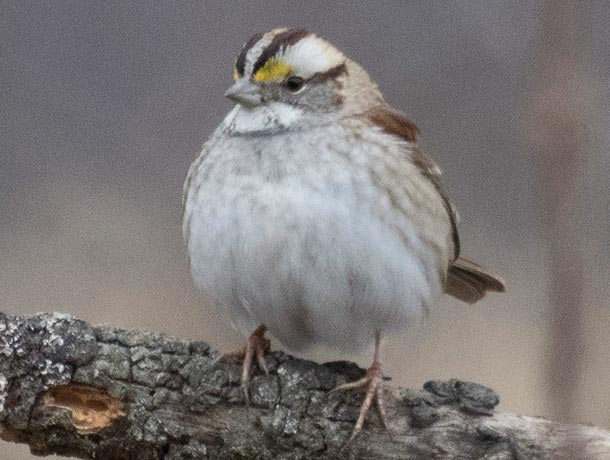
White-stripe individuals are brighter
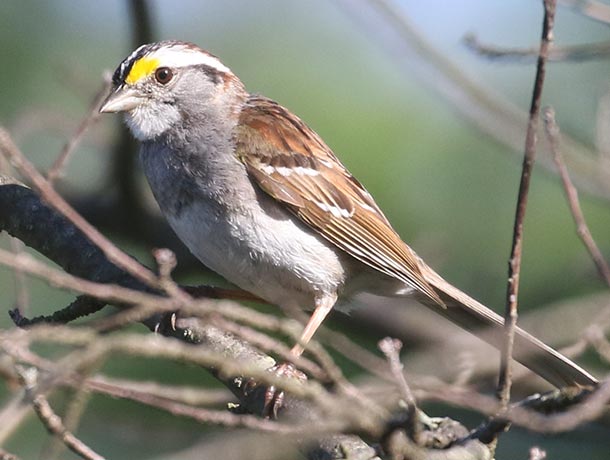
By spring, the brightest individuals can be quite striking
White-crowned Sparrow
Mostly a migrant species in the northeast, but some do winter, particularly in Pennsylvania. This is another species that is often in brush, but doesn't hesitate to be out in the open as well. The plumage is overall plain (other than the head), but distinguished. The head pattern is similar to White-throated, but with bold black and white stripes, and no yellow lores. This is also the only sparrow species in this article where you have to worry about an immature plumage that is significantly different throughout the winter. The head pattern on the immature birds has brown instead of black stripes, and the white hasn't filled in between them.
ID Keys: Black and white stripes on head (browner version of the same pattern on immatures).
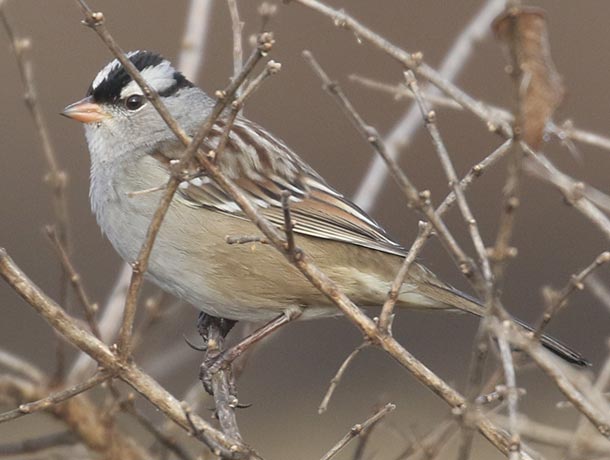
Distinctive bold head pattern, with alternating black and white stripes
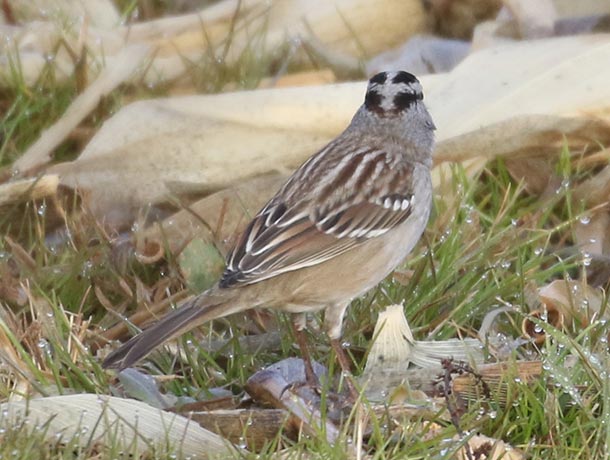
The black stripes do not meet in the back
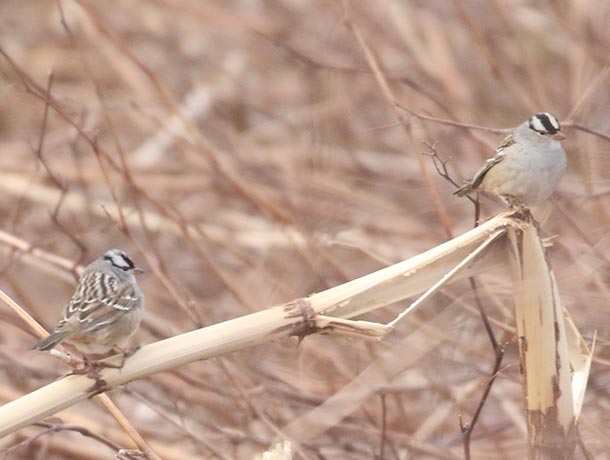
The distinctive head pattern is recognizable even with more distant views
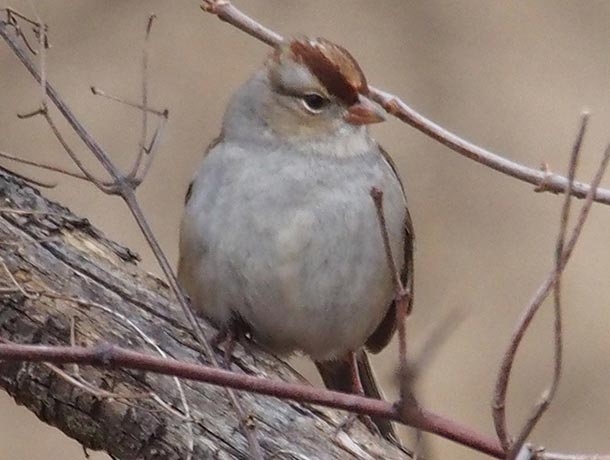
Immatures have a different color pattern on the head, with brown instead of black, and no white stripes
Swamp Sparrow
As the name suggests, these are usually found in wetlands or somewhat wet brush. They are fairly uncommon in winter. They give a very "rusty" impression overall, with reddish tons throughout much of the plumage, and especially the wings. White-throated is probably the most similar species, but on Swamp, notice the different facial pattern (usually a brownish cheek patch) and solid gray back of the neck. White-throated also shows a white wingbar, which Swamp lacks. Be warned that a small number of Swamp Sparrows will show a bit of a yellow cast to the lores, and can show a white throat, but these features are never as strong as in White-throated.
ID Keys: Overall rusty look; rufous wings with no wingbars.
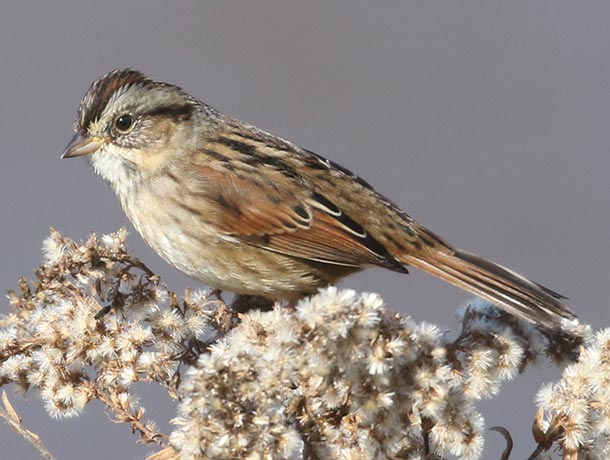
Extensive rufous in the wings, and no wingbars
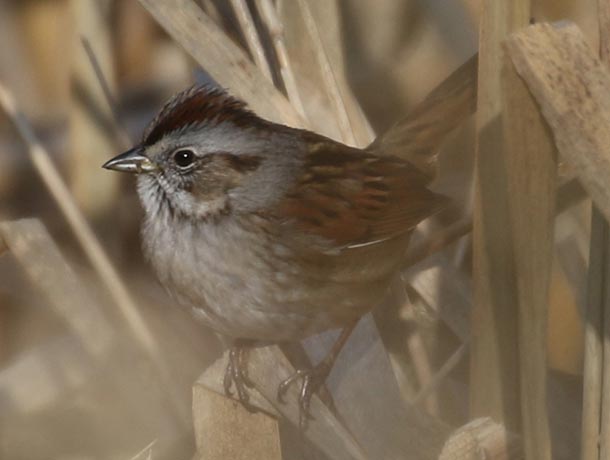
Gray back of neck
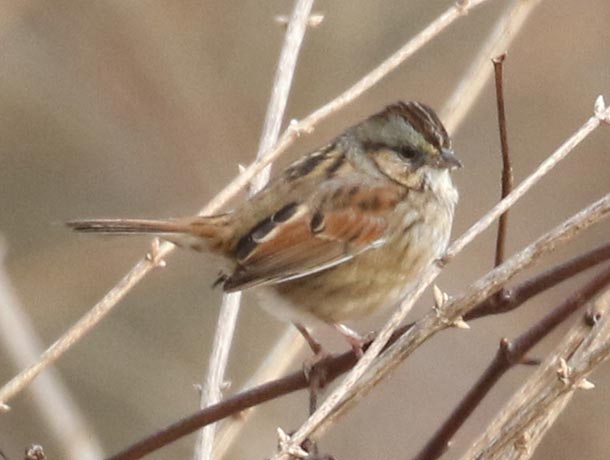
Overall rusty looking
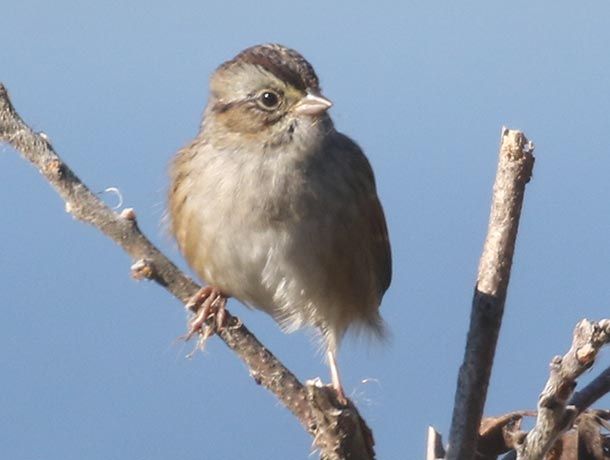
Sometimes shows weak yellow in the lores, but not as strong as White-throated Sparrow
Field Sparrow
Like the previous couple of species, Field Sparrows mostly clear out of the northeast in winter, but some individuals do stick around. Other than the white eyering, not too many features stand out, but notice the overall orangey look (sometimes replaced by a lot of gray, but the head normally will have some orange/rufous tones) with pink bill and legs.
ID Keys: White eyering; orangey and gray plumage; pink bill.
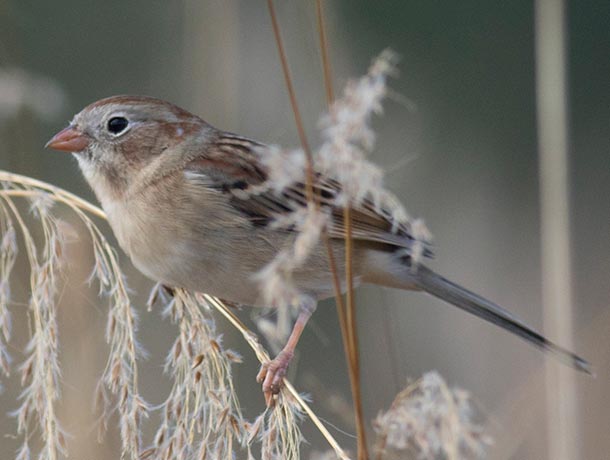
White eyering and pink bill
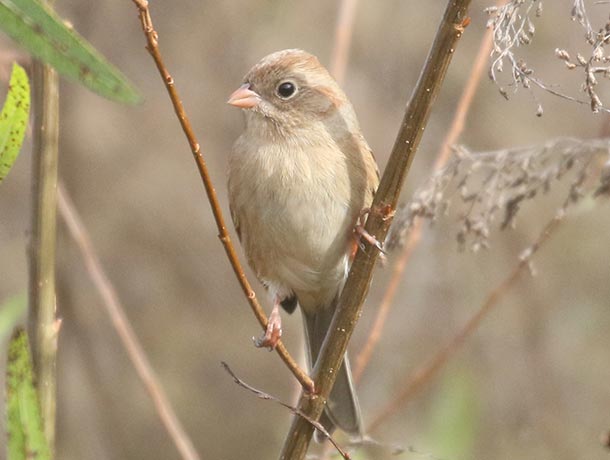
Many are quite orange-looking
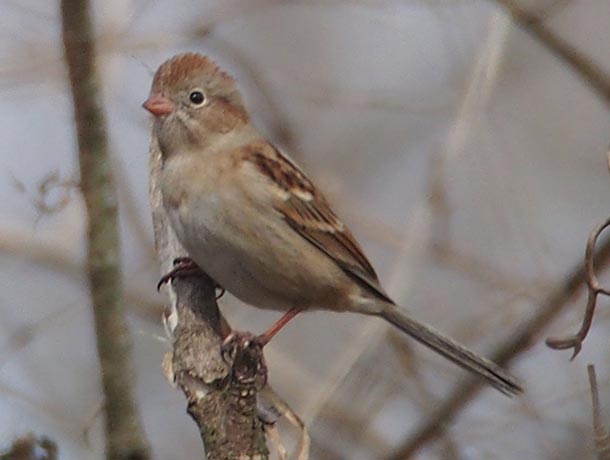
Orange head with pink bill and white eyering gives a pretty distinctive head pattern
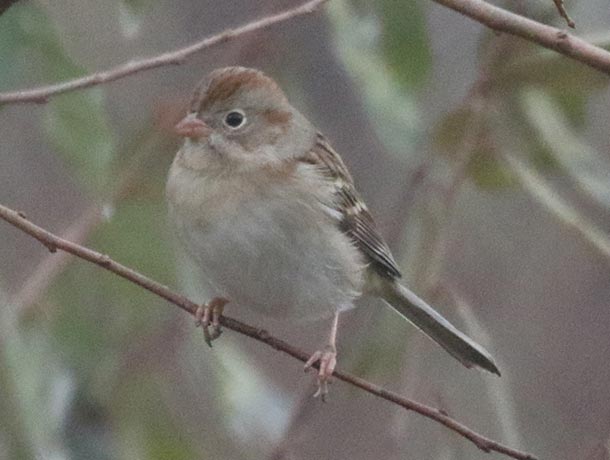
Some individuals are a lot more gray than orange
House Sparrow
House Sparrows are not in the same family as the sparrows we have covered so far, and were introduced to North America. The males are less likely to be confused with anything else, with their black throat and bib (Harris's Sparrow is a rare visitor to the east that can show similar).
In the winter, males and females both have yellowish bills that are larger than the other species. Their overall build is pretty stocky.
Females have less distinctive plumage, with fairly plain underparts and face, with only a weak line behind the eye. Can be confused with Chipping Sparrow, but note the different bill, and the unmarked lores (vs. dark lores on Chipping Sparrows, as the eyeline continues through the eye).
ID Keys: Black throat and bib on males; stocky shape; large, yellowish bill.
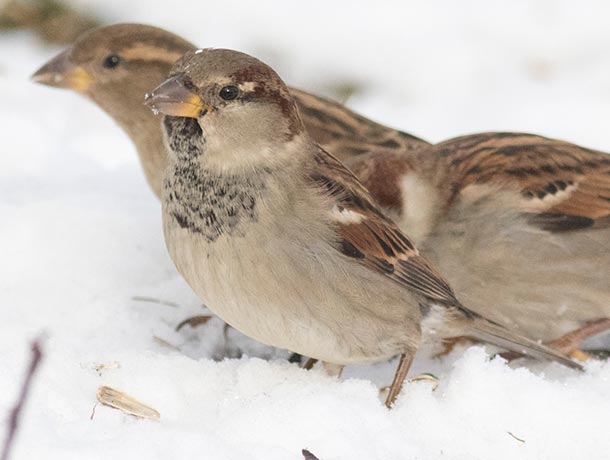
Males have a black bib
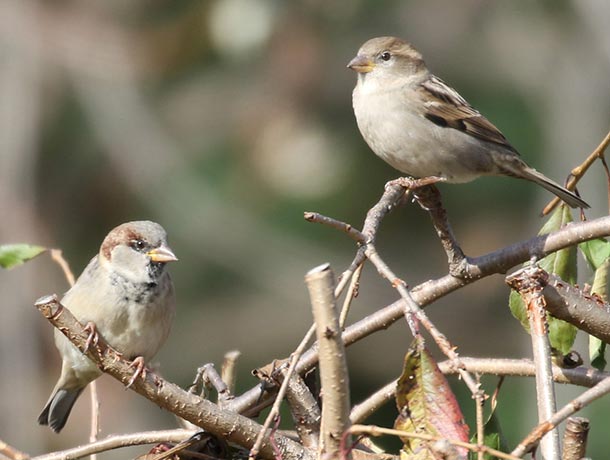
Fairly stocky build
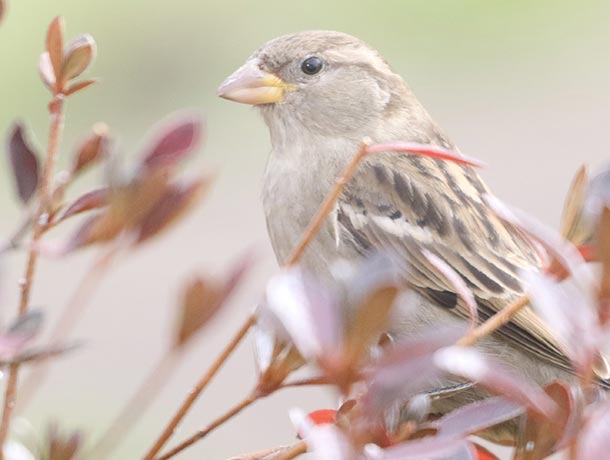
Large yellowish bill
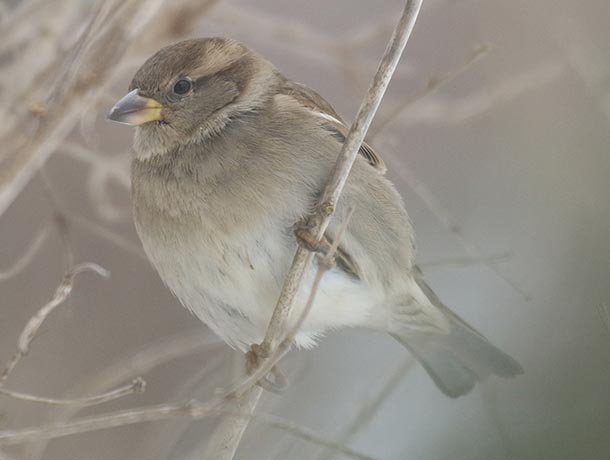
Females are plain-looking with a weak eyeline (but it doesn't continue onto the lores like in Chipping Sparrow)
Unstreaked Sparrow Practice Quiz
Sparrow-like Species
Sometimes one of the biggest hang-ups in sparrow identification is trying to figure out which sparrow you are looking at when it isn't actually a sparrow at all! Not every "little brown bird" is in the sparrow family. This section will cover some of the common confusion species.
Finches
Finches are probably the most sparrow-like family overall, especially the females. In general, they call more than sparrows in flight, tend to be seen out in the open (and in trees) more, and many species have forked tails.
House Finch — Extremely common feeder visitor. Males have a significant amount of red, so are unlikely to be confused with sparrows. Females (and young males) are less strongly marked than the streaked sparrows, and have less intricately-marked backs. This is a species you want to really study well, as it serves as a nice baseline species, and gives plenty of opportunities for close looks at feeders.
Purple Finch — Pretty similar to House Finches. Males are raspberry-colored, and females (and young males) differ from House Finches by a slightly different bill shape, and facial pattern. Separating the two species is beyond the scope of this article, but this video covers the basics, if you are interested.
Pine Siskin — a small, very streaky finch with a thin pointed bill and usually showing a nice amount of yellow in the wings.
Common Redpoll — Fairly siskin-like, but with a small yellow bill and a red circle on their head. Hoary Redpoll is very similar, but even less likely to be confused with a sparrow since they are paler.
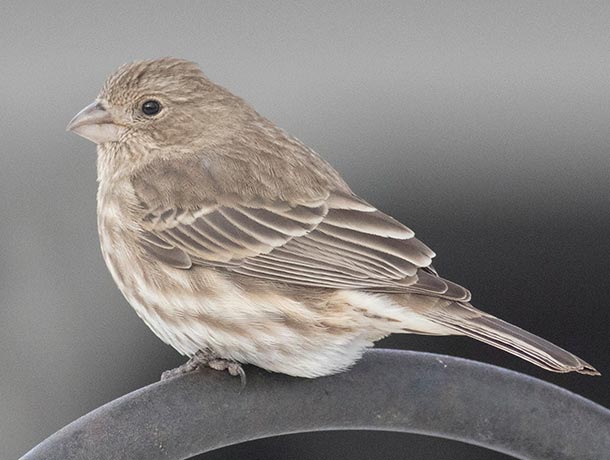
House Finch
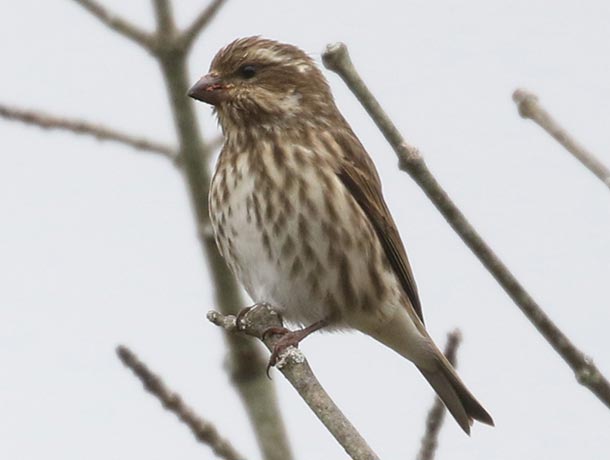
Purple Finch
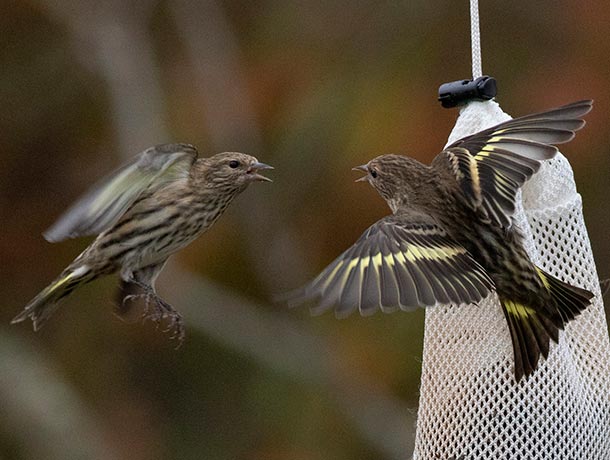
Pine Siskins

Common Redpolls
Field Birds
The following species tend to be found in flocks (sometimes intermixed with each other), typically in open areas such as farm fields. All of them will often flush up and fly around while calling repeatedly, which sparrows don't really do.
Horned Lark — Fairly bold facial pattern, usually with a lot of yellow. Bill shape and overall posture quite different from sparrows.
Snow Bunting — Way more white on the body than any sparrow shows, and you will note extensive white in the wings when they are flying as well.
Lapland Longspur — More sparrow-like than the previous two, this species tends to be less common (in PA at least), but often found mixed into flocks of Horned Larks or Snow Buntings. Note the different habits than most sparrows, and the broad chestnut-colored stripe in the wings.
American Pipit — The thin bill and strong call notes should easily help you to rule out sparrow on this one. They tend to have a fairly bouncy walking style on their long legs, another clue that this isn't a sparrow.
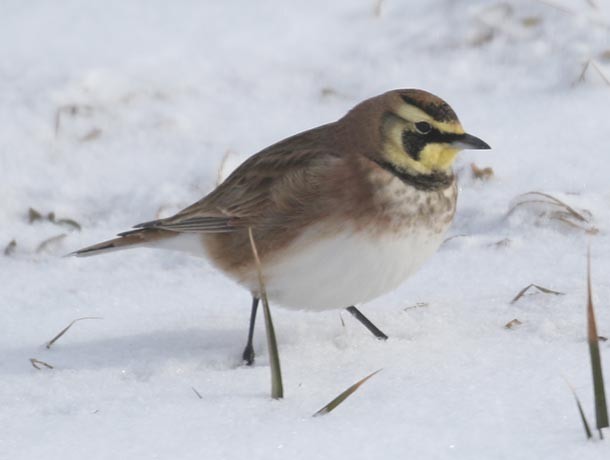
Horned Lark
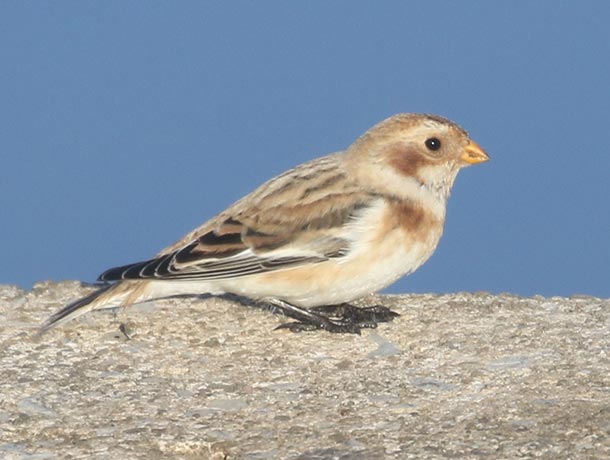
Snow Bunting
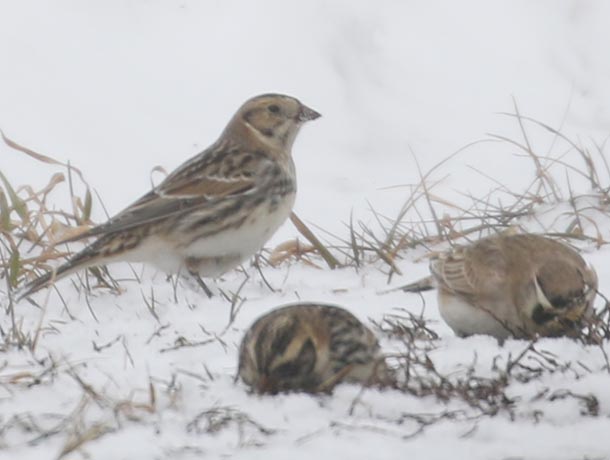
2 Lapland Longspurs feeding with a Horned Lark (R)
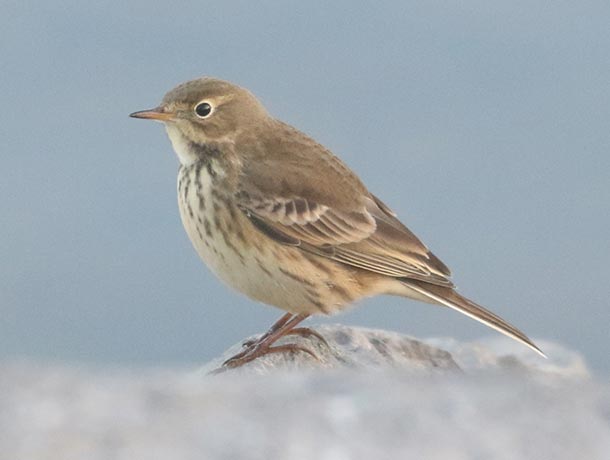
American Pipit
Blackbirds
Red-winged Blackbird — The males are unlikely to be confused with a sparrow, but the females are one of the most frequently misidentified birds in the northeast. Don't worry if you've mistaken them for a sparrow before; you are in good company. They are quite a bit larger than any of the streaked sparrows, and note the different bill to help separate from the sparrows.
Brown-headed Cowbird — Again, the males are unlikely to pose much trouble in relation to sparrows, but the female-type plumage is drab, and gives a lot of beginner birders problems. I've often heard it joked that the main field mark for female cowbirds is that there are no field marks, and indeed, there aren't really any features that stand out. Look for the overall low contrast drab brown, with slightly paler throat and heavy bill.
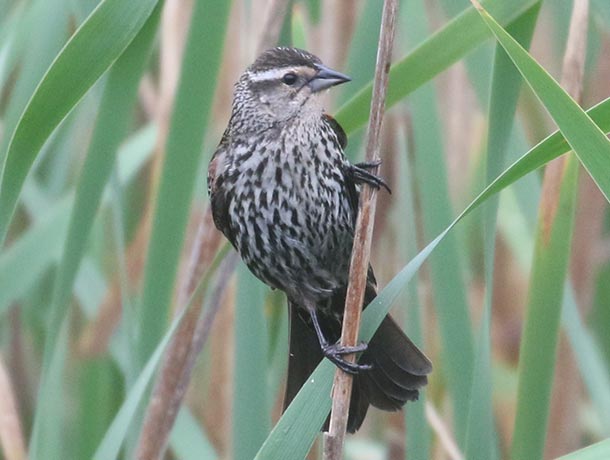
Red-winged Blackbird
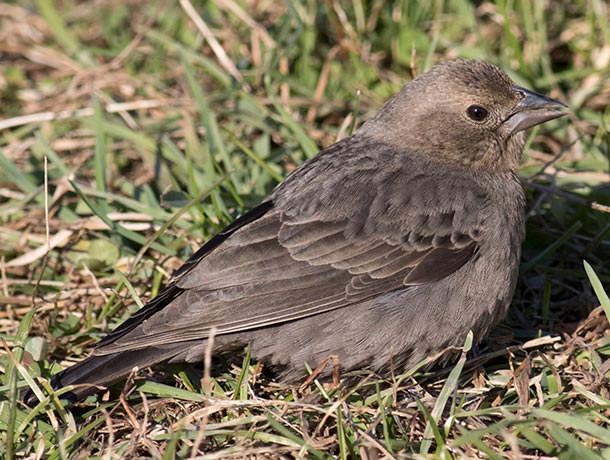
Brown-headed Cowbird
Wrens
Winter Wren — The bill alone should be enough to rule out a sparrow on this one; it's far thinner than any sparrow. They like to hide out in heavy brush in winter, and are, at times, sort of mouse-like in their movements when they do come out into the open.
Carolina Wren — Regular residents in residential areas, and also found in a variety of other habitat with some brush. Very vocal. The reddish back, with barring on the wings and tail, along with the distinct white eyebrow are not shown by any sparrow. Note, again, the bill shape, which is very different from sparrows.
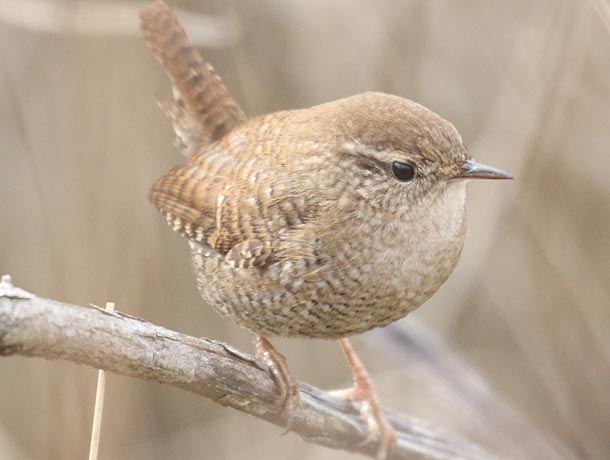
Winter Wren
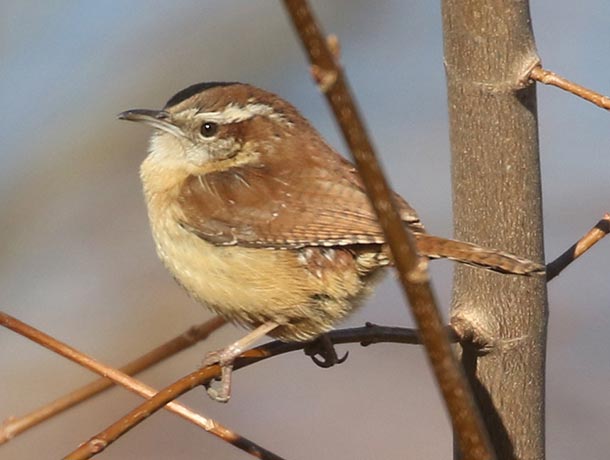
Carolina Wren
Conclusion
Hopefully you are feeling a little more confident in sparrows at this point. Like I said in the introduction, this isn't all of the possible sparrows you could encounter, but these species will provide a great base to use to learn the additional "warm weather" sparrows.
Additional species you will definitely want to study for the warmer months (or rarer species in the winter) are: Grasshopper Sparrow, Vesper Sparrow, Henslow's Sparrow (very localized breeding species, pretty rare elsewhere), along with some rare but fairly regular species (or coastal), including Clay-colored Sparrow, Lark Sparrow, Harris's Sparrow, LeConte's Sparrow, and Nelson's Sparrow.
If you really want to cover your bases with rare species (or bird along the coast, where some of these are a lot more common), also take a look at: Brewer's Sparrow, Lark Bunting, Golden-crowned Sparrow, Seaside Sparrow, Saltmarsh Sparrow, Green-tailed Towhee, and Spotted Towhee.
Also take a look at your general field guide, and pay attention to range maps for what is expected in your area. There are also some sparrow-specific books, two of which I will link to below:
Disclosure: We earn commissions for purchases made through the links above.
And, as always, photos are never a replacement for good field study of birds. You will start to pick up intangible aspects of these sparrows, especially the common ones. With time, you'll be able to quickly and confidently identify a lot of these species from brief partial views (which is very helpful given the skulky habits of some of these birds). So, get out there and find some brush to "work." Embrace the learning process, and don't be frustrated if you can't ID every bird you are seeing. Anyone who is putting a name to every bird, even with extremely poor looks, is probably misidentifying some.
All photos © Bobby Brown or David Brown.
The banner photo at the top of the page is an American Tree Sparrow, but if you read the guide, you should know that!
Like this? Want to help fund more tools and projects on our site?
Support LycoBirds

